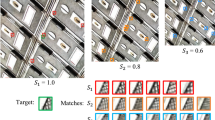Abstract
Compressive Sampling (CS) achieves the sub-Nyquist image acquisition, which bringing about a rapid development of compressive imaging devices. In CS framework, the adaptive sampling scheme is an efficient approach to improving the rate-distortion performance of imaging system. However, the sampling allocation depends on the original sample image, which increases the cost and complexity of imaging system, thereby making CS lose its superiority. In this paper, we propose a saliency-based adaptive CS scheme that allocates more sampling resources to salient regions but fewer to non-salient regions. Its key idea is to extract the saliency information by using the contrast between CS measurements, thus avoiding the original sample image in the imaging system. The scheme is realized in practice without any changes of the architecture of compressive imaging device. To match our adaptive sampling scheme, we also propose a weighted global recovery model based on saliency information. This model can effectively suppress the blocking artifacts while improving the visual qualities of salient regions. Experimental results on natural images show that the proposed adaptive CS scheme improves the visual quality of reconstructed image, and has better rate-distortion performance than the existing adaptive CS schemes.









Similar content being viewed by others
References
Candè EJ, Wakin MB (2008) An introduction to compressive sampling. IEEE Signal Process mag 25(2):21–30
Chen Y, Hao C, Wu W, Wu E (2016) Robust dense reconstruction by range merging based on confidence estimation. SCIENCE CHINA Inf Sci 59(9):1–11
Duarte MF, Davenport MA, Takbar D, Laska JN, Sun T, Kelly KF, Baraniuk RG (2008) Single-pixel imaging via compressive sampling. IEEE Signal Process Mag 25(2):83–91
Figueiredo MAT, Nowak RD, Wright SJ (2007) Gradient projection for sparse reconstruction: application to compressed sensing and other inverse problems. IEEE J Sel Top Sign Proces 1(4):586–597
Gan L (2007) Block compressed sensing of natural images. In: Proceedings of 15th IEEE International Conference on Digital Signal Processing, pp 403–406
Itti L, Koch C (2001) Computational modelling of visual attention. Nat Rev Neurosci 2(3):194–203
Itti L, Koch C, Niebur E (1998) A model of saliency-based visual attention for rapid scene analysis. IEEE Trans Pattern Anal Mach Intell 20(11):1254–1259
Li R, Gan Z, Cui Z, Wu M, Zhu X (2013) Distributed adaptive compressed video sensing using smoothed projected Landweber reconstruction. China Commun 10(11):58–69
Muhammad K, Ahmad J, Sajjad M, Baik SW (2016) Visual saliency models for summarization of diagnostic hysteroscopy videos in healthcare systems. SpringerPlus 5(1):1495
Muhammad K, Sajjad M, Mi YL, Baik SW (2017) Efficient visual attention driven framework for key frames extraction from hysteroscopy videos. Biomed Signal Proces Control 33:161–168
Pan Z, Zhang Y, Kwong S (2015) Efficient motion and disparity estimation optimization for low complexity multiview video coding. IEEE Trans Broadcast 61(2):166–176
Pan Z, Jin P, Lei J, Zhang Y, Sun X, Kwong S (2016) Fast reference frame selection based on content similarity for low complexity HEVC encoder. J Vis Commun Image Represent 40(Part B):516–524
Pan Z, Lei J, Zhang Y, Sun X, Kwong S (2016) Fast motion estimation based on content property for low-complexity H.265/HEVC encoder. IEEE Trans Broadcast 62(3):675–684
Stankovi V, Stankovi L, Cheng S (2009) Compressive image sampling with side information. In: Proceedings of IEEE International Conference on Image Processing, pp 3037–3040
Tan J, Ma Y, Rueda H, Baron D, Arce GR (2016) Compressive hyperspectral imaging via approximate message passing. IEEE J Sel Top Sign Proces 10(2):389–401
Wang Z, Bovik AC, Sheikh HR, Simoncelli EP (2004) Image quality assessment: from error visibility to structural similarity. IEEE Trans Image Process 13(4):600–612
Wu X, Dong W, Zhang X, Shi G (2012) Model-assisted adaptive recovery of compressed sensing with image applications. IEEE Trans Image Process 21(2):451–458
Yu Y, Wang B, Zhang L (2010) Saliency-based compressive sampling for image signals. IEEE Signal Process Lett 17(11):973–976
Zhang J, Zhao D, Xiong R et al (2014) Group-based sparse representation for image restoration. IEEE Trans Image Process 23(8):3336–3351
Zhang J, Xiang Q, Yin Y, Chen C, Luo X (2017) Adaptive compressed sensing for wireless image sensor networks. Multimedia Tools Appl 76(3):4227–4242
Acknowledgements
This work was supported in part by the National Natural Science Foundation of China, under Grants nos. 61501393, 61601396, 61572417 and 61502409, in part by Youth Sustentation Fund of Xinyang Normal University, under Grant no. 2015-QN-043, in part by the Key Scientific Research Project of Colleges and Universities in Henan Province of China, under Grant no. 16A520069.
Author information
Authors and Affiliations
Corresponding author
Rights and permissions
About this article
Cite this article
Li, R., He, W., Liu, Z. et al. Saliency-based adaptive compressive sampling of images using measurement contrast. Multimed Tools Appl 77, 12139–12156 (2018). https://doi.org/10.1007/s11042-017-4862-z
Received:
Revised:
Accepted:
Published:
Issue Date:
DOI: https://doi.org/10.1007/s11042-017-4862-z




